Hydrazonoyl Chlorides as Precursors for Synthesis of Novel Bis-Pyrrole Derivatives
Abstract
:1. Introduction
2. Results and Discussion
2.1. Chemistry
2.2. Antimicrobial Evaluation
2.3. Docking and Molecular Modeling
3. Materials and Methods
3.1. Chemistry
3.1.1. General
3.1.2. Synthesis of Bis-Pyrrole Derivatives 5a–e
3.2. Agar Diffusion Well Method to Determine the Antimicrobial Activity
3.3. Docking Studies
4. Conclusions
Acknowledgments
Conflicts of Interest
References
- Mabkhot, Y.N.; Barakat, A.; Al-Majid, A.M.; Alshahrani, S.; Yousuf, S.; Choudhary, M.I. Synthesis, reactions and biological activity of some new bis-heterocyclic ring compounds containing sulphur atom. Chem. Cent. J. 2013, 7, 112–120. [Google Scholar] [CrossRef] [PubMed]
- Kumar, R.; Panwar, H. Synthesis and pharmacological evaluation: antimicrobial, anti-inflammatory, analgesic, ulcerogenic properties of several bis-heterocyclic derivatives. Indonesian J. Pharm. 2015, 26. [Google Scholar] [CrossRef]
- Bhanu Prakash, T.; Dinneswara Reddy, G.; Padmaja, A.; Padmavathi, V. Synthesis and antimicrobial activity of amine linked bis- and tris-heterocycles. Eur. J. Med. Chem. 2014, 82, 347–354. [Google Scholar]
- Tripathi, A.; Fornabaio, M.; Kellogg, G.E.; Gupton, J.T.; Gewirtz, D.A.; Yeudall, W.A.; Vega, N.E.; Mooberry, S.L. Docking and hydropathic scoring of polysubstituted pyrrole compounds with antitubulin activity. Bioorg. Med. Chem. 2008, 16, 2235–2242. [Google Scholar] [CrossRef] [PubMed]
- Micheli, F.; di Fabio, R.; Cavanni, P.; Rimland, J.M.; Capelli, A.M.; Chiamulera, C.; Corsi, M.; Corti, C.; Donati, D.; Feriani, A.; et al. Synthesis and pharmacological characterisation of 2,4-dicarboxy-pyrroles as selective non-competitive mGluR1 antagonists. Bioorg. Med. Chem. 2003, 11, 171–183. [Google Scholar] [CrossRef]
- Krutzik, P.O.; Chamberlin, A.R. Rapid solid-phase synthesis of DNA-binding pyrrole-imidazole polyamides. Bioorg. Med. Chem. Lett. 2002, 12, 2129–2132. [Google Scholar] [CrossRef]
- Lv, K.; Wang, L.L.; Liu, M.L.; Zhou, X.B.; Fan, S.Y.; Liu, H.Y.; Zheng, Z.B.; Li, S. Synthesis and antitumor activity of 5-[1-(3-(dimethylamino)propyl)-5-halogenated-2-oxoindolin-(3Z)-ylidenemethyl]-2,4-dimethyl-1H-pyrrole-3-carboxamides. Bioorg. Med. Chem. Lett. 2011, 21, 3062–3065. [Google Scholar] [CrossRef] [PubMed]
- Baraldi, P.G.; Romagnoli, R.; Pavani, M.G.; Nunez, M.D.C.; Bingham, J.P.; Hartley, J.A. Benzoyl and cinnamoyl nitrogen mustard derivatives of benzoheterocyclic analogues of the tallimustine: Synthesis and antitumour activity. Bioorg. Med. Chem. 2002, 10, 1611–1618. [Google Scholar] [CrossRef]
- Kang, S.Y.; Park, E.J.; Park, W.K.; Kim, H.J.; Jeong, D.; Jung, M.E.; Song, K.S.; Lee, S.H.; Seo, H.J.; Kim, M.J.; et al. Arylpiperazine-containing pyrrole 3-carboxamide derivatives targeting serotonin 5-HT2A, 5-HT2C and the serotonin transporter as a potential antidepressant. Bioorg. Med. Chem. Lett. 2010, 20, 1705–1711. [Google Scholar] [CrossRef] [PubMed]
- Holub, J.M.; O’Toole-Colin, K.; Getzel, A.; Argenti, A.; Evans, M.A.; Smith, D.C.; Dalglish, G.A.; Rifat, S.; Wilson, D.L.; Taylor, B.M.; et al. Lipid-lowering effects of ethyl 2-phenacyl-3-aryl-1H-pyrrole-4-carboxylates in rodents. Molecules 2004, 9, 134–157. [Google Scholar] [CrossRef] [PubMed]
- Almerico, A.M.; Diana, P.; Barraja, P.; Dattolo, G.; Mingoia, F.; Putzolu, M.; Perra, G.; Milia, C.; Musiu, V.; Marongiu, M.E. Glycosidopyrroles. Part 2. Acyclic derivatives: 1-(1,3-dihydroxy-2-propoxy)methyl pyrroles as potential antiviral agents. Farmaco 1997, 52, 667–672. [Google Scholar] [PubMed]
- Ramazanzadeh, R.; Nasiri, F. Dimethyl 2-hydroxy-1-methyl-3-[2-Oxo-2-Phenylethylidene]-2-Phenyl-1,2-Dihydro-3H-Pyrrole-4,5-dicarboxylate: A potential lead compound as anti-gram-positive and anti-gram-negative agent. J. Applied Sci. 2009, 9, 2198–2200. [Google Scholar] [CrossRef]
- Shawali, A.S.; Abdallah, M.A. The Chemistry of Heterocyclic Hydrazonoyl Halides. Adv Heterocycl. Chem. 2001, 80, 277–338. [Google Scholar]
- Shawali, A.S.; Edrees, M.M. Reactions of nitrilimines with heterocyclic amines and enamines. Convenient methodology for synthesis and annulation of Heterocycles. Arkivoc 2006, 9, 292–365. [Google Scholar] [CrossRef]
- Kheder, N.A.; Mabkhoot, Y.N. Synthesis and antimicrobial studies of some novel bis-[1,3,4]thiadiazole and bis-thiazole pendant to thieno[2,3-b]thiophene moiety. Int. J. Mol. Sci. 2012, 13, 3661–3670. [Google Scholar] [CrossRef] [PubMed]
- Mabkhot, Y.N.; Kheder, N.A.; Al-Majid, A.M. Facile and convenient synthesis of new thieno[2,3-b]thiophene derivatives. Molecules 2010, 15, 9418–9426. [Google Scholar] [CrossRef] [PubMed]
- Darwish, E.S.; Kheder, N.A.; Farag, A.M. Synthesis and antimicrobial evaluation of some new pyridine based Heterocycles. Heterocycles 2010, 81, 2247–2256. [Google Scholar]
- Mabkhot, Y.N.; Kheder, N.A.; Farag, A.M. An efficient synthesis of new thiazole based heterocycles. Heterocycles 2010, 81, 2369–2376. [Google Scholar]
- Dawood, K.M.; Kheder, N.A.; Ragab, E.A.; Mohamed, S.N. A facile access to some new pyrazole, 1,3,4-thiadiazole, and thiophene derivatives via B-ketosulfones. Phosphorus Sulfur Silicon Relat. Elem. 2010, 185, 330–339. [Google Scholar] [CrossRef]
- Farag, A.M.; Kheder, N.A.; Mabkhot, Y.N. Synthesis and antimicrobial evaluation of new pyrazole, thiophene, thiazole and 1,3,4-thiadiazole derivatives incorporating pyrimidine ring. Heterocycles 2009, 78, 1787–1798. [Google Scholar] [CrossRef]
- Kheder, N.A. Convenient synthesis of novel bis(hydrazone) and bis(indole) derivatives. Heterocycles 2009, 78, 1281–1288. [Google Scholar] [CrossRef]
- Kheder, N.A. Synthesis of some novel bis(pyrazole), bis(pyridine) and bis-pyrazolo[5,1-c]-1,2,4-triazine derivatives. Heterocycles 2009, 78, 1815–1822. [Google Scholar] [CrossRef]
- Kheder, N.A.; Mabkhoot, Y.N.; Farag, A.M. Synthesis and antimicrobial evaluation of some bis(thioxopyridine), bis(pyrazolo[3,4-b]pyridine), bis(thieno[2,3-b]pyridine), bis(1,3,4-thiadiazole) and bis(thiophene) derivatives. Heterocycles 2008, 75, 2937–2948. [Google Scholar]
- Kheder, N.A.; Mabkhot, Y.N.; Farag, A.M. Facile and convenient synthesis of pyrazole, pyridine, pyridazine, pyrazolo[3,4-b]pyridine, and pyrazolo[5,1-c][1,2,4]-triazine derivatives. Synth. Commun. 2008, 38, 3170–3182. [Google Scholar] [CrossRef]
- Kheder, N.A.; Farghaly, T.A. Bis-Hydrazonoyl chloride as precursors for synthesis of novel polysubstituted bis-azoles. Arab. J. Chem. 2013. [Google Scholar] [CrossRef]
- Shyadligeri, A.S.; Gadaginamath, G.S.; Subramanian, L.R. One-pot synthesis of a novel 1,1′-bridged bis(benzo(g)indole) diester and the preparation of some of its derivatives. J. Chem. Res. 1996, 2, 114–115. [Google Scholar] [CrossRef]
- Zhang, Z.L.; Jin, S.; Shang, Z.; Huang, S.; Liu, B.; Guo, J. Diethyl (Z,Z)-3,3′-(ethane-1,2-diyldi-imino)dibut-2-enoate. Acta Crystallogr. C 2004, 60, o176–o177. [Google Scholar] [CrossRef] [PubMed]
- Dieckmann, W.; Platz, L. Ueber eine neue Bildungsweise von Osotetrazonen. Ber. Dtsch. Chem. Ges. 1905, 38, 2986–2990. [Google Scholar] [CrossRef]
- Abushamleh, A.S.; Al-Aqarbeh, M.M.; Day, V. Transition Metal Complexes of Derivatized Chiral Dihydro-1,2,4-triazin-6-ones. Template Synthesis of Nickel(II) Tetraaza-(4N-M) Complexes Incorporating the Triazinone Moiety. Am. J. Appl. Sci. 2008, 5, 750–754. [Google Scholar] [CrossRef]
- Eweiss, N.F.; Abdelhamid, A.O. Synthesis of Heterocycles. Part II. New routes to acetyl thiadiazolines and alkylazothiazoles. J. Heterocycl. Chem. 1980, 17, 1713–1717. [Google Scholar] [CrossRef]
- Tanoli, S.A.K.; Tanoli, N.U.; Usmani, S.; Ferreira, A.G. The exploration of interaction studies of smaller size, mostly ignored yet intrinsically inestimable molecules towards BSA; An example of STD and DOSY NMR. Cent. Eur. J. Chem. 2014, 12, 332–340. [Google Scholar] [CrossRef]
- Protein Data Bank. Available online: http://www.rcsb.org/pdb (accessed on 1 March 2016).
- Smania, A.; Monache, F.D.; Smania, E.F.A.; Cuneo, R.S. Triterpenes and sterols from ganoderma australe (Fr) Pat. (Aphyllophoromycetideae). Int. J. Med. Mushrooms 1999, 1, 325–334. [Google Scholar]
- Sample Availability: Samples of the compounds 5a–e are available from the author.
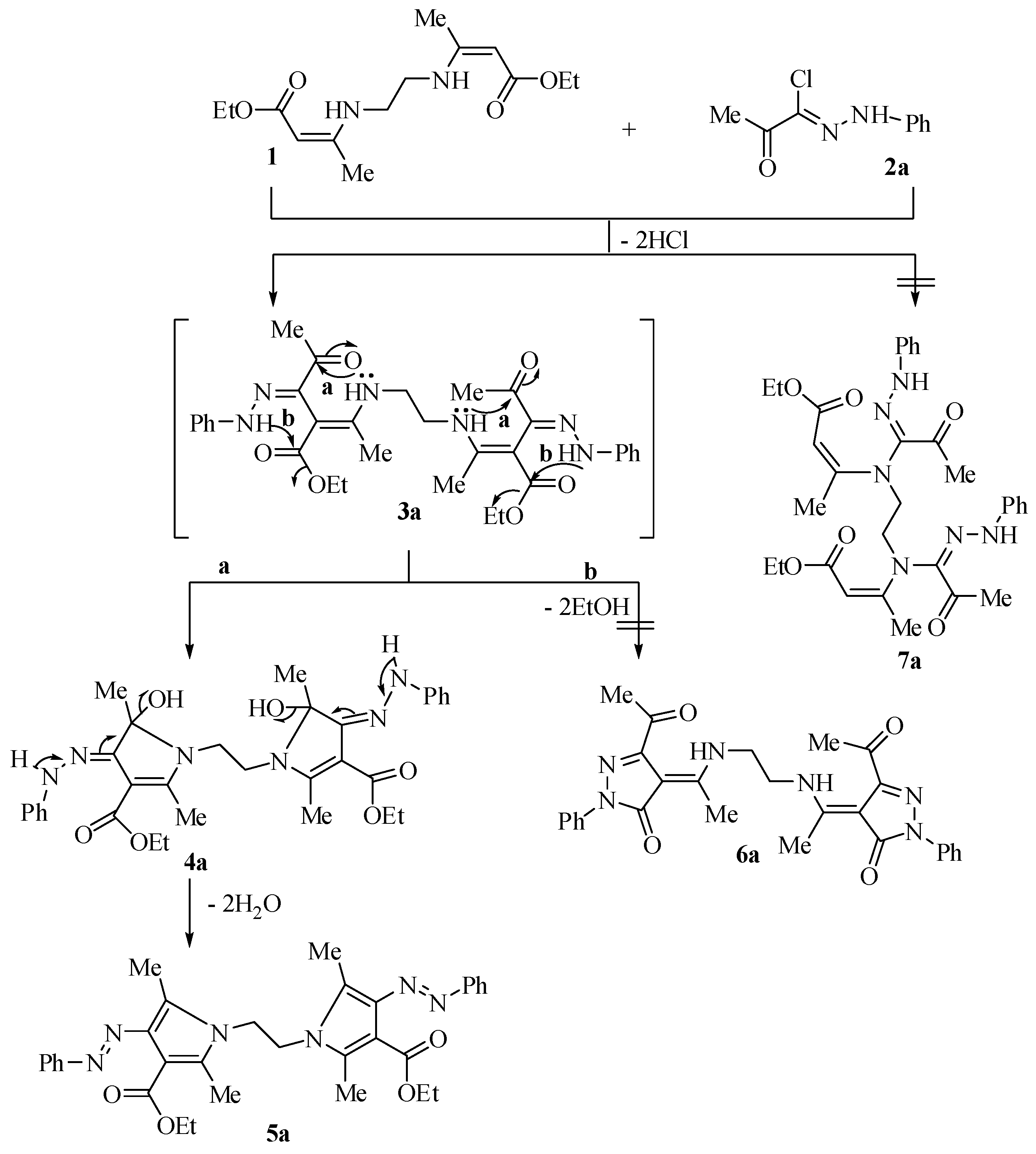
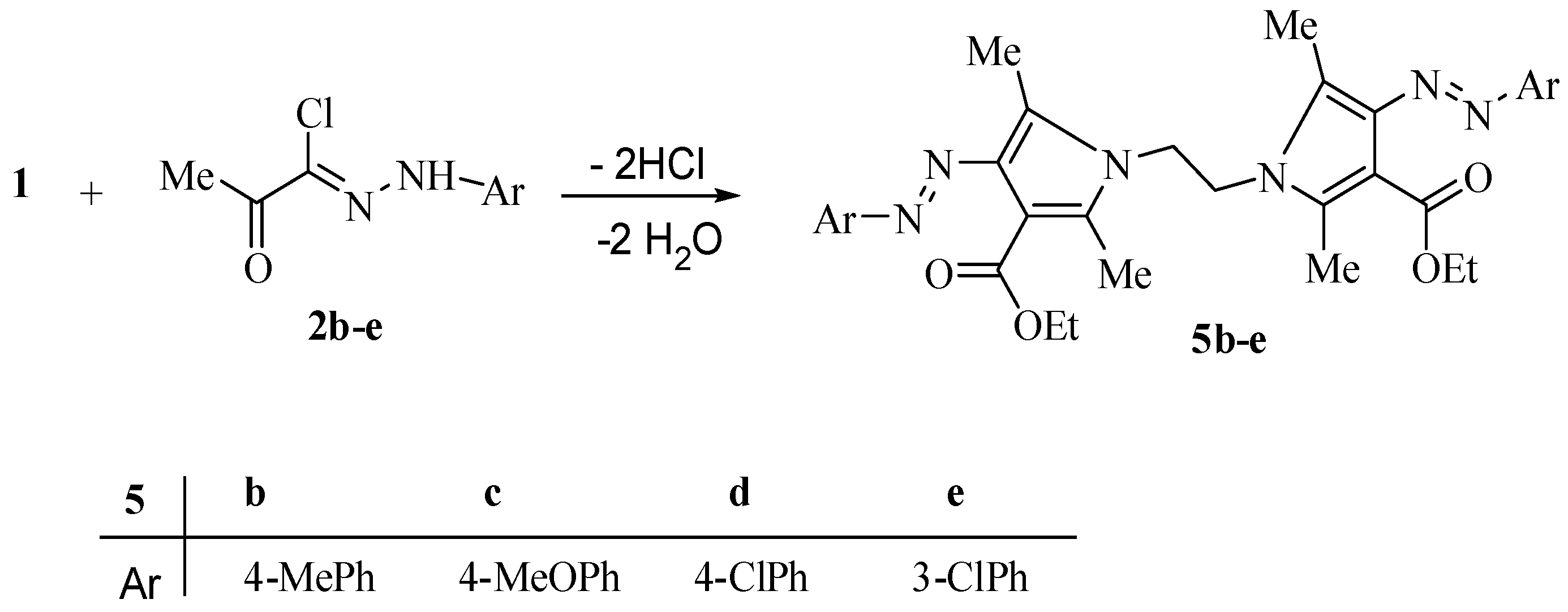
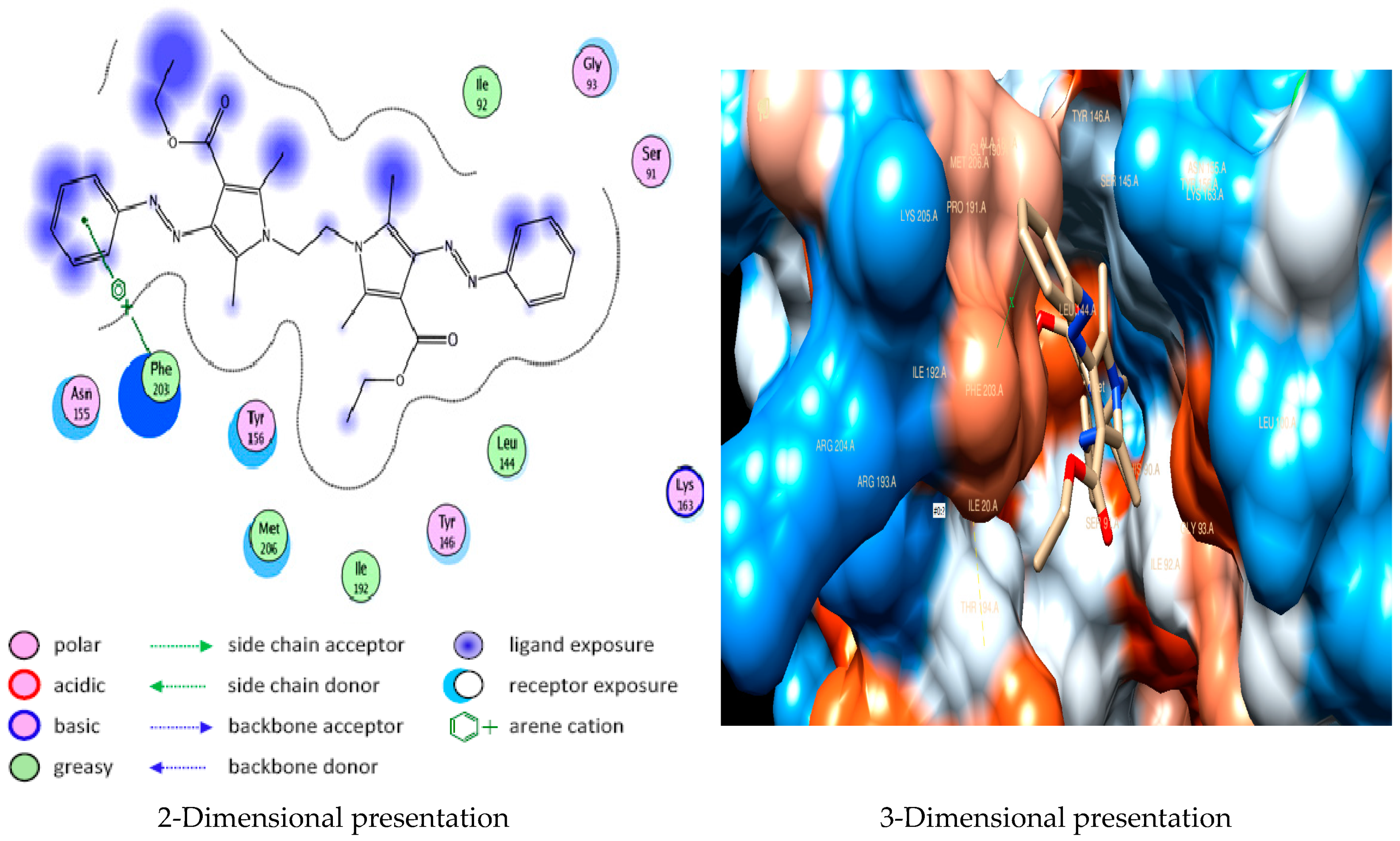
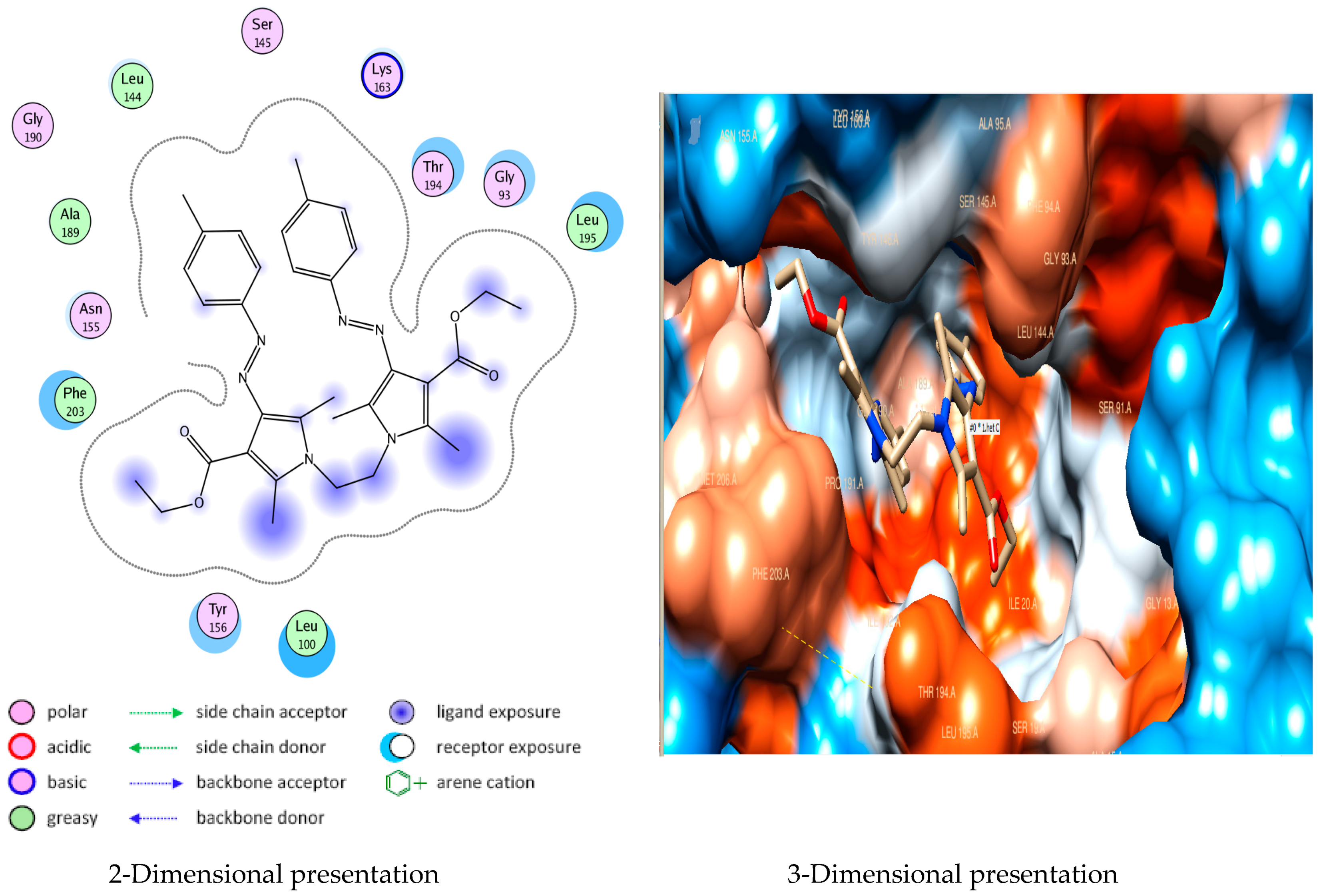
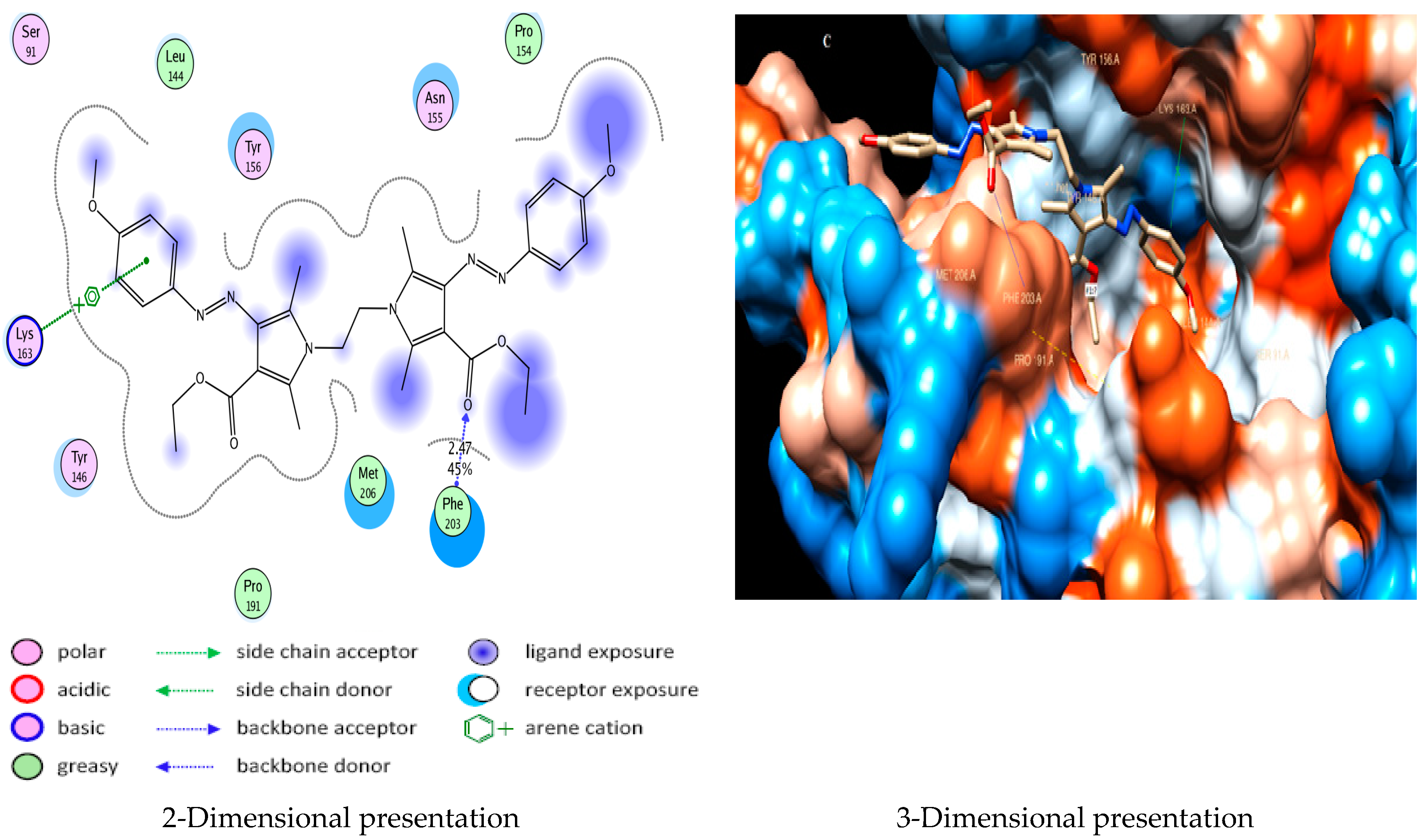
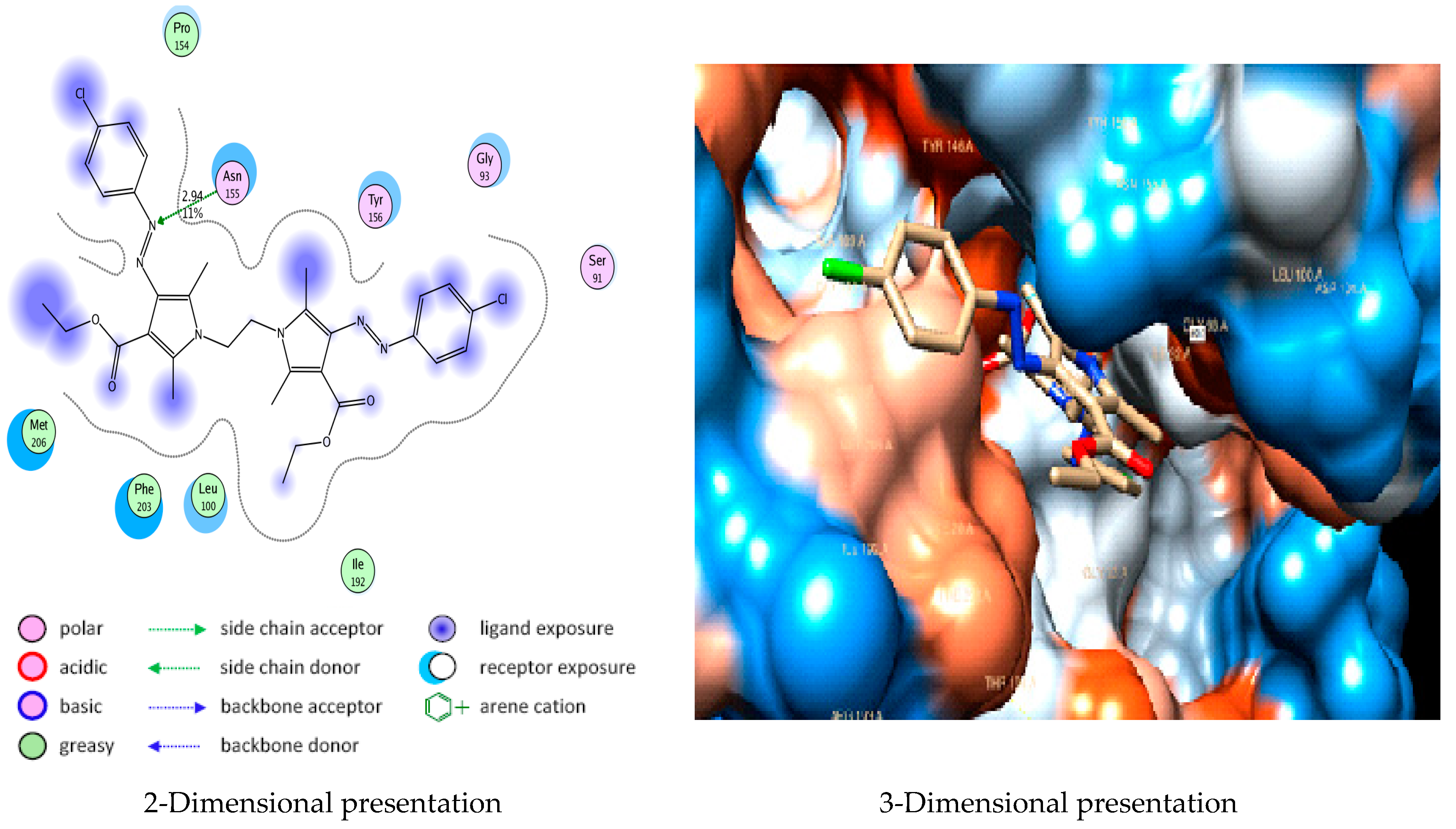

| Microorganisms | Compound Tested | Standard (30 µg/mL) | |||
|---|---|---|---|---|---|
| 5a | 5b | 5d | 5e | ||
| Fungi | Itraconazole | ||||
| Aspergillus fumigatus (RCMB 002003) | 18.2 ± 0.84 | 11.3 ± 0.68 | 21.1 ± 0.2 | 16.3 ± 0.09 | 22 ± 0.1 |
| Geotrichumcandidum (RCMB 052006) | 18.9 ±0.35 | 12.6 ±0.54 | 19.3 ± 0.05 | 15.4 ± 0.1 | 26 ± 0.3 |
| Syncephalastrum racemosum (RCMB 005003) | 11.2 ± 0.44 | NA | 16.4 ± 0.08 | 14.2 ± 0.05 | 19 ± 0.1 |
| Candida albicans (RCMB 005002) | NA | NA | NA | NA | 24 ± 0.1 |
| Gram-positive Bacteria | Penicillin G | ||||
| Staphylococcus aureus (RCMB 000106) (MSSA) | 17.8 ± 0.58 | 10.7 ± 0.36 | 21.4 ± .03 | 17.9 ± 0.03 | 27.4 ± 0.08 |
| Bacillis subtilis (RCMB 000107) | 17.9 ± 0.46 | 11.1 ± 0.72 | 26.1 ± 0.04 | 15.2 ± 0.04 | 28.6 ± 0.03 |
| Gram-negative Bacteria | Streptomycin | ||||
| Pseudomonas aeruginosa (RCMB 000102) | NA | NA | 19.9 ± 0.09 | NA | 26.3 ± 0.03 |
| Escherichia coli (RCMB 000103) | 12.6 ± 0.57 | 12.4 ±0.04 | 17.2 ± 0.2 | 13.4 ± 0.04 | 30.1 ± 0.07 |
© 2016 by the authors. Licensee MDPI, Basel, Switzerland. This article is an open access article distributed under the terms and conditions of the Creative Commons by Attribution (CC-BY) license ( http://creativecommons.org/licenses/by/4.0/).
Share and Cite
Kheder, N.A. Hydrazonoyl Chlorides as Precursors for Synthesis of Novel Bis-Pyrrole Derivatives. Molecules 2016, 21, 326. https://doi.org/10.3390/molecules21030326
Kheder NA. Hydrazonoyl Chlorides as Precursors for Synthesis of Novel Bis-Pyrrole Derivatives. Molecules. 2016; 21(3):326. https://doi.org/10.3390/molecules21030326
Chicago/Turabian StyleKheder, Nabila Abdelshafy. 2016. "Hydrazonoyl Chlorides as Precursors for Synthesis of Novel Bis-Pyrrole Derivatives" Molecules 21, no. 3: 326. https://doi.org/10.3390/molecules21030326






